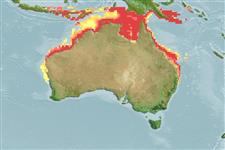Common names from other countries
>
Scombriformes (Mackerels) >
Scombridae (Mackerels, tunas, bonitos) > Scombrinae
Etymology: Scomberomorus: Latin, scomber = mackerel + Greek, moros = silly, stupid (Ref. 45335).
More on author: Macleay.
Environment: milieu / climate zone / depth range / distribution range
экология
морской; солоноватоводный; мигрирует в океане (Ref. 51243); пределы глубины ? - 100 m (Ref. 6390). Tropical; 7°S - 30°S, 112°E - 157°E (Ref. 168)
Western Pacific: southern Papua New Guinea and northern Australia, from Shark Bay, Western Australia to northern New South Wales. Reports of this species from Thailand and Malaysia are based on misidentifications.
Length at first maturity / Size / Вес / Возраст
Maturity: Lm ?, range 75 - ? cm
Max length : 120 cm FL самец/пол неопределен; (Ref. 168); наибольший вес (опубликованные данные): 10.0 kg (Ref. 168)
колючие лучи спинного плавника (общее число) : 13 - 15; членистые (мягкие) лучи спинного плавника (общее число) : 19 - 22; колючие лучи анального плавника: 0; членистые (мягкие) лучи анального плавника: 19 - 22; позвонки: 44 - 46. Interpelvic process small and bifid. Lateral line gradually curving down toward caudal peduncle. Intestine with 2 folds and 3 limbs. Swim bladder absent. Body covered with small scales. Juveniles (less than 10 cm) marked with 12-20 vertical bands which becomes less distinct or break into spots in larger fish.
Found more commonly around coastal headlands and rocky reefs but are also caught offshore (Ref. 6390). Juveniles (4.5 to 10 cm length) are commonly encountered during November along the beaches of Townsville, Queensland and grow to twice this size by January. They are pelagic predators, feeding exclusively on baitfish (sardines and herrings (Ref. 30572). Caught also with set lines aside from trolling with small lures or cut bait. Marketed fresh and frozen; eaten fried, broiled and baked (Ref. 9988).
Life cycle and mating behavior
Maturities | размножение | Spawnings | Egg(s) | Fecundities | личинки
Collette, B.B. and C.E. Nauen, 1983. FAO Species Catalogue. Vol. 2. Scombrids of the world. An annotated and illustrated catalogue of tunas, mackerels, bonitos and related species known to date. Rome: FAO. FAO Fish. Synop. 125(2):137 p. (Ref. 168)
Статус Красного Списка МСОП (Ref. 130435)
CITES (Ref. 128078)
Not Evaluated
Угроза для людей
Reports of ciguatera poisoning (Ref. 6390)
Использование человеком
рыболовство: коммерческий; объект спортивного рыболовства: да; наживка: occasionally
дополнительная информация
инструменты
Специальные отчеты
Скачать в формате XML
ресурсы в Интернет
Estimates based on models
Preferred temperature (Ref.
115969): 25.9 - 28.7, mean 27.7 (based on 506 cells).
Phylogenetic diversity index (Ref.
82804): PD
50 = 0.5000 [Uniqueness, from 0.5 = low to 2.0 = high].
Bayesian length-weight: a=0.00832 (0.00383 - 0.01808), b=3.03 (2.86 - 3.20), in cm Total Length, based on LWR estimates for this Genus-body shape (Ref.
93245).
Trophic level (Ref.
69278): 4.5 ±0.80 se; based on food items.
устойчивость к внешним воздействиям (Ref.
120179): средний (среднего размера), минимальное время удвоения популяции 1.4-4.4 года (K=0.6; tm=1-2; tmax=12).
Fishing Vulnerability (Ref.
59153): Moderate to high vulnerability (49 of 100).
